Analysis of patenting data over the last century shows that during upheavals patenting, and by reflection, innovation, ploughs on irresistibly despite the crisis. But what areas of innovation does crisis stimulate? Unsurprisingly, the innovation mirrors the nature of the crisis. Perhaps more surprisingly is evidence suggesting that the outcomes are not de novo innovation, but adoption of technologies that had been developed that were looking for a purpose. In article two we look at innovation modes coming out of crisis, and set up the question for the third article – what can we predict in terms of innovation arising from the current pandemic, and what is the technology that has been lying there waiting to be taken up.
We have seen that patenting activity naturally levels during crises which affect subsistence or economy, though against a background of robust long-term growth. But what were the specific effects on innovation during and, significantly, after previous crises? By looking at lessons from World War II, the oil crisis of 1973, and the “Great Recession” of 2008 we can perhaps go on to weave a few strands together around the current pandemic.
Innovation during and after World War II
It is clear that patenting remained an important objective even during the wartime years, presumably as inventors hoped to see the economic benefit once the war was over. It is also clear that a large amount of the innovation during the period was driven by the necessity of defence requirements. Some of the innovation has passed into legend, but the legend is well supported by the underlying data. More interesting still are some of the downstream beneficial consequences that came out of the astonishing period of creativity during World War II. As the saying goes, “Innovation loves a crisis”.
Crisis as innovation accelerator
The wartime period can probably be best identified as an accelerator of existing early stage technologies rather than an initiator of new technologies. Perhaps the most famous war time development – the production of sophisticated radar systems – is a good example of that; the concept had been proposed in the mid-1930s but the rapidity of development to a scalable and workable system at the very outset of the war was unbelievable, driven in the UK for example by defence needs in relation to the Battle of Britain. Other examples include penicillin which, again, was known but which saw unprecedented development during the Second World War (rendering it non-toxic), the emergence of workable jet engines and the development of full-scale rocket technology.
Crisis as collaboration driver
Another impact of the wartime requirements was the increase in collaboration between research entities, driven by government requisition needs in many cases. An area of innovation that had a profound and permanent impact was occasioned by the increase of research in relation to petroleum derivatives driven by the shortage of natural rubber from Asia; synthetic petroleum-based rubber products were in full scale production by the end of the war. This was fuelled by patent pooling of multiple chemical companies, allowing sharing of research and contingent acceleration of development.
Crisis and serendipity
It’s also worth bearing in mind that some serendipitous inventions arose during the period; duct tape was developed for military purposes but of course is ubiquitous now, super glue was a by-product of research into improved gun sights, and the Slinky™ spring was intended for stabilisation of delicate ship components! WWII drove a startling amount of targeted, but ultimately blue sky research, casting wide for creative solutions to specific problems, and solving unexpected problems along the way.
Turning to the data, it is clear that these “headline stories” provide a strong representation of the underlying reality. Graph 6 shows the biggest filers between 1930 and 1960, and the technical breakdown is rapidly apparent – a mix of engineering, telecoms and petrochemicals operations make a very strong showing. This would have been fuelled, and stimulated by the war effort. But harking back to the previous article, graph 7 shows in incontrovertible terms the impact on one company – pre-war, German company Siemens had a busy and productive patent filing cycle, and this grew rapidly from the late 1940 However, for two years immediately after the war, patenting was at essentially zero, during the period when Germany’s infrastructure was destroyed. The war was behind a huge surge in innovation, but also, briefly its almost total cessation.
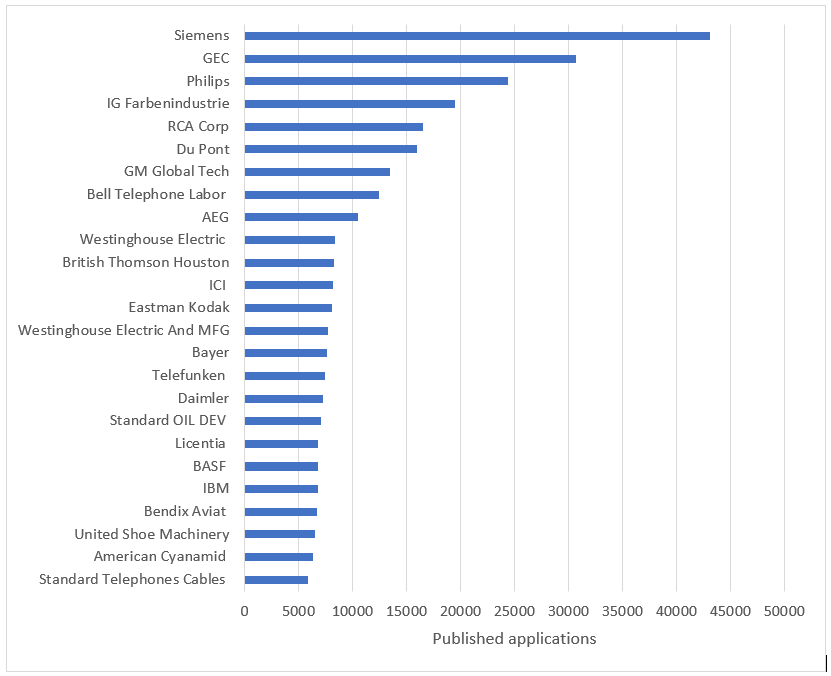 Graph 6 – top patent filers 1930-1960
Graph 6 – top patent filers 1930-1960
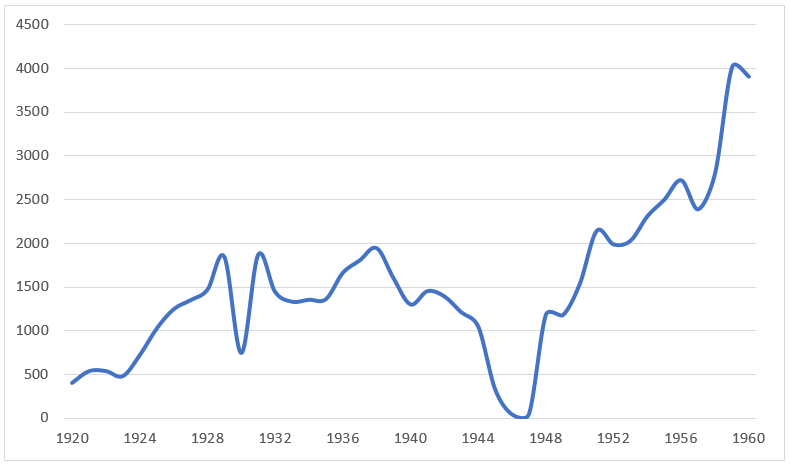
Graph 7 - Siemens patent application filings 1920-1960
Crisis and consequence
The peace time consequences of wartime innovation still resonate now, from the prevalence of plastics (for better or for worse) through to the multiple chemical products that are still in use. However, one area where the full commercial potential perhaps was not recognised at the time, but which now governs every aspect of our life was the enhancement to computer and communications technology. The obvious example is the building of the first electronic computer for code-breaking purposes and the steps towards implementation of the revolutionary concept of programmability of devices. On the communications front, notoriously, the screen icon Hedy Lamarr co-invented an improvement on frequency hopping technology; again, this was building on work by Tesla and Marconi, but spread spectrum telecommunications technology still relies heavily on research such as this.
Again, there is data behind the legend. Graph 8 shows the busiest areas of patenting by classification area between 1935 and 1950. The most activity was around hydrocarbons, that is, petrochemical, again following on from the huge surge in research during World War II. The second highest area was valves, in other words, early electronics, followed closely by electric switches, showing the massive rise in this area after the advances during the conflict. The work of Hedy Lamarr, Alan Turing and many, many other less famous names resonated through the next twenty years and even to the present.
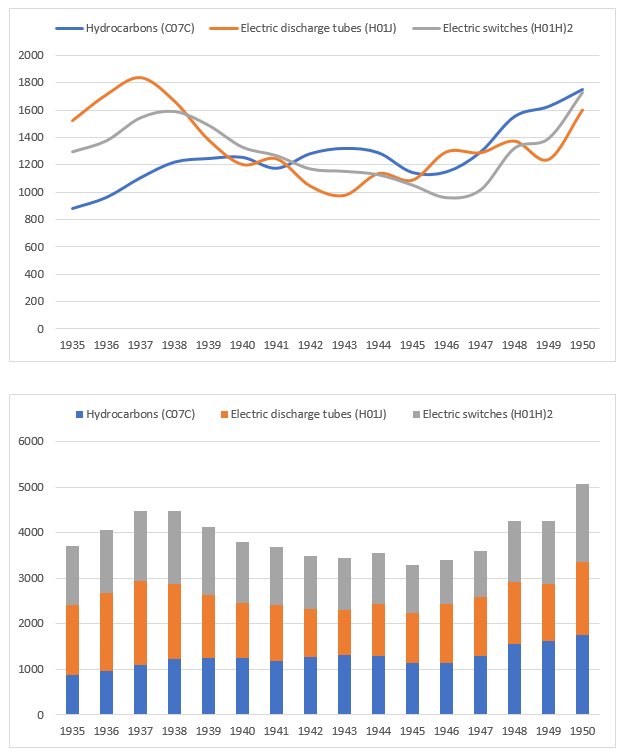
Graph 8 - Top IPCs between 1935-1950
And then there are the serendipitous inventions that arose out of the innovations of the Second World War – who knew that freeze dried coffee would use technology developed for storing penicillin! Perhaps the most remarkable though is the development of the microwave oven. Before the war, radar technology was known but extremely ineffective; during the war, the rapid improvements in magnetrons allowed the creation of radiofrequency sources of the intensity required and after the war, someone noticed that the magnetrons kept heating up their sandwiches and invented the microwave oven!
The 1973 Energy Crisis
Threats to the oil economy had been predicted since the 1950s, focussing on the sustainability of the resource, but the crisis in the 1970s was triggered by artificial reduction in supply. At the time, the shift of emphasis to alternative energy sources was driven more by the lack of availability of oil than by environmental concerns, although those were increasing as well. However, the immediate outcome of the crisis was to increase focus and innovation in relation to a range of untried technologies including wind power and geothermal on an industrial scale.
We have already seen in the first article the peaks in growth of innovation relating to renewable energy that followed on from two oil crises (and perhaps more surprisingly, the Chernobyl disaster). But the four heat maps below all show the evolution of the areas of research during the period. The Cold War was perhaps of too great a duration to show clear trends on patenting activity, but the 1960s was all about nuclear energy, possibly as a by-product of the weapons race that was going on. In the 1970s there is a shift to a more general approach to renewable energy – fuel cells and in particular solar technology began to match nuclear technology in terms of patenting activity. The 1980s did not signal the end of nuclear research, but new technological areas including wind generation and in particular super conductivity became dominant whilst in the 1990s nuclear research diminished enormously, while further work on renewable batteries and the various “conventional” alternatives such as wind and solar continued. The oil crisis was undoubtedly the initial spur for all of these areas of growth as people scrabbled for an alternative to reliance on fossil fuels, but it largely acted as an accelerator for technology that has now become important in its own right as an antidote to climate change.
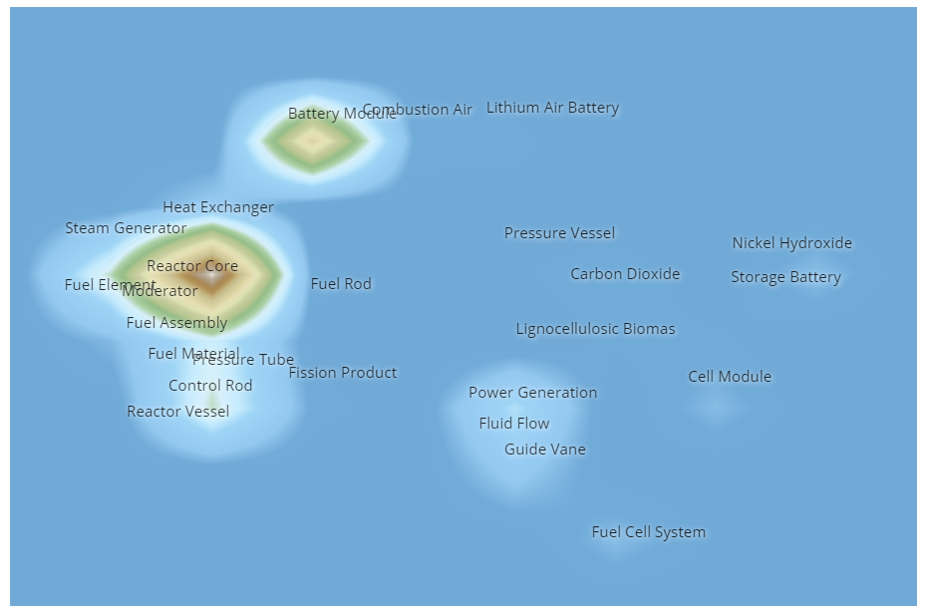 1960s – focussed on nuclear
1960s – focussed on nuclear
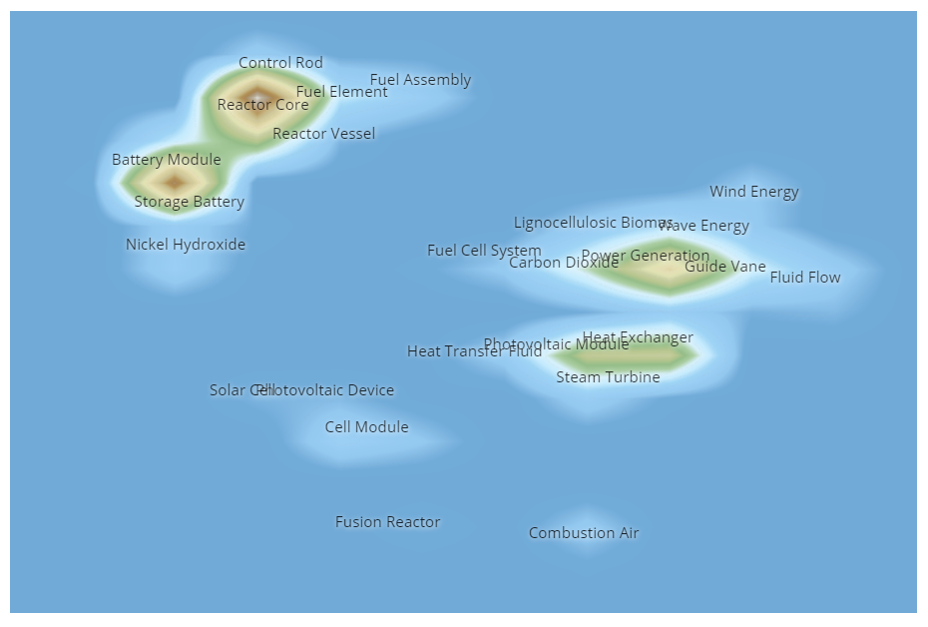
1970s nuclear still important (see dark brown contour for reactor core). Other solutions start to grow
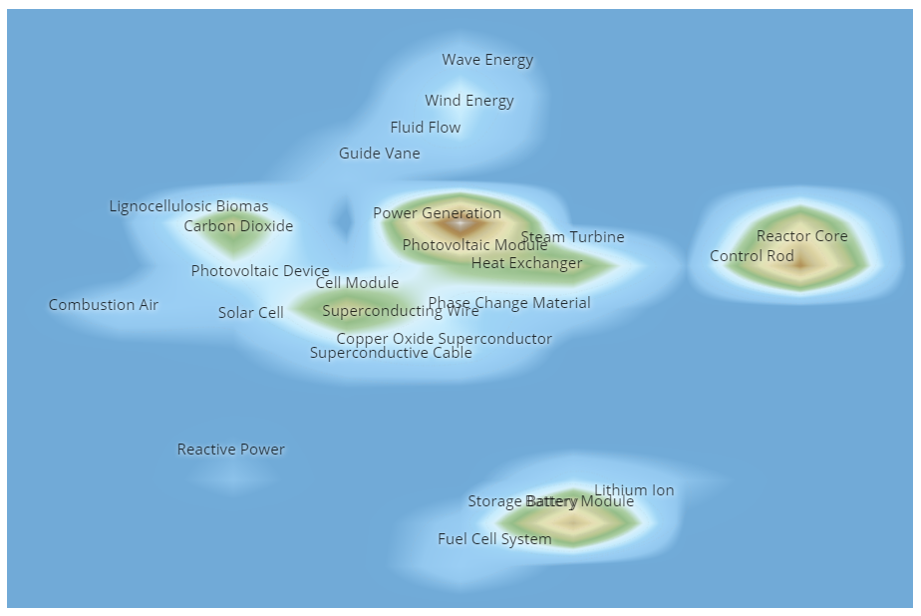
1980s Superconductors boom
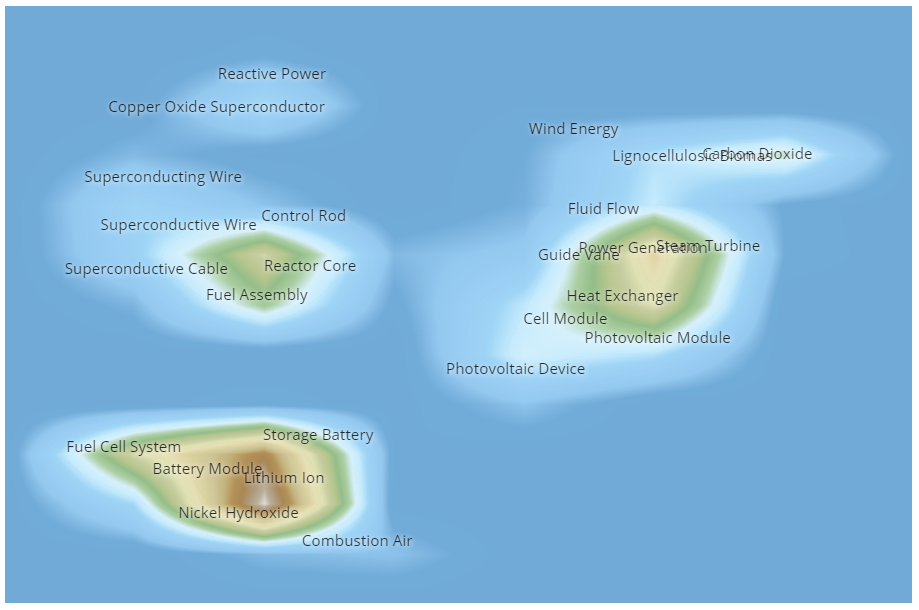
1990s nuclear almost disappears. Lithium and renewable tech grow
There were multiple pragmatic improvements as well at an individual/domestic level. The US automotive industry suffered hugely as a result of a move to reduced fuel consumption vehicles. An enhanced understanding of the sheer energy inefficiency of people’s houses was an immediate outcome leading to vast improvements in insulation and other domestic energy saving considerations. Again, even though the reasoning behind them has shifted away from “availability of oil” to “undesirability of oil” we see the benefits today.
The Great Recession of 2007-8
The relationship between the financial crisis and innovation is slightly different. Without suggesting that it was any less of a problem for huge swathes of humanity, in some ways it can be viewed as a more “artificial” crisis than the others, largely arising from convoluted mathematical unlikelihoods upon which an emerging economic model was based. The role of innovation was different, indeed to some extent it has been suggested that it was innovation, albeit in a non-technological sense, that was part of the cause of the crash – derivatives, sub-prime mortgages and the like. It’s less easy to identify beneficial innovations that came out of the crisis, at least in the technical sense that patents are directed to. What is evident is the economic impact: as liquidity decreases, so does access to investment for innovation.
The heat maps are a little more difficult to interpret in this case. Pre-recession, there was lower level activity in what we now term “fintech”, but this changed after the recession. A wider variety of technologies were investigated in the fintech space and terms like “blockchain” and “smart contract” start to appear. In fact, the main lesson we learn from the heat maps is the difficulty of mapping the patent system onto the financial services sector and the lack of consistent terminology that typically underpins the patent classification system. Put another way, it’s difficult to identify genuine technical benefits from a large swathe of the fintech innovation post-recession.

1999-2008 – no clear focus to fintech | 2009-2018 – innovative technologies appear
So, interestingly, there seems to be quite a difference between the financial crisis and the preceding energy and defence crises; it shared the economic downsides but, perhaps because of its intangible nature, fewer of the innovation benefits, at least in a technological sense.
Conclusion
The current pandemic is certainly more aligned with the war and oil crises as it is a real, tangible human-level problem as a result of which physical solutions are required, and that is where potential technical patentable innovations are most likely to derive. In a sense, if we can take any comfort from the nature of the pandemic, we should see an uptick in technical innovation which will have contemporaneous accelerating effect, hopefully coupled with serendipitous follows-ons in the years to come. Already we are seeing collaboration taking place, which was a signature of previous upheavals. Building on these trends, we will look at the possible impact on innovation in the next article.
Contact Gwilym to discuss anything in this article. He loves a chat.
Many thanks to our co-author Costas Stephanides for contributing to this article.